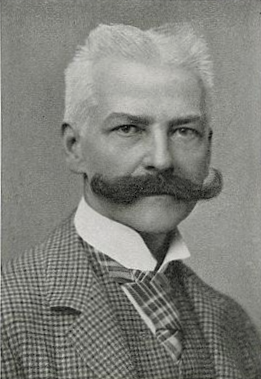A cyclorama is a panoramic image on the inside of a cylindrical platform, designed to give viewers standing in the middle of the cylinder a 360° view, and also a building designed to show a panoramic image. The intended effect is to make viewers, surrounded by the panoramic image, feel as if they were standing in the midst of the place depicted in the image.

Albert von Keller was a German painter of Swiss ancestry. He specialized in portraits and indoor scenes. Female figures are a prominent feature of his work.

Franz Roubaud was a Russian painter of French origin who created some of the largest and best known panoramic paintings. He created circular paintings, exposed on a cylindrical surface and viewed from the inside at a lookout point. His paintings were often believed to reproduce the original scene with high fidelity.

The Academy of Fine Arts, Munich is one of the oldest and most significant art academies in Germany. It is located in the Maxvorstadt district of Munich, in Bavaria, Germany.

Leo von Klenze was a German architect and painter. He was the court architect of Ludwig I of Bavaria.

Gabriel Cornelius Ritter von Max was a Prague-born Austrian painter, and professor of history painting at the Royal Academy of Fine Arts. He was also a collector of anthropological artifacts.

Hans Beat Wieland was a Swiss painter, best known for his realist paintings of Alpine sceneries.
Franz Zeno Diemer was a flight pioneer in Bavaria, setting a number of world records, and Flight Officer for Bavarian Lifeguard Regiment.

The Battle of Bazeilles was fought on 1 September 1870 during the Franco-Prussian War as a portion of the larger Battle of Sedan and was one of the first battles to feature modern urban warfare tactics. It took place in Bazeilles, France, a small village in the department of Ardennes near Sedan, and involved a force of Bavarian soldiers battling against French marines and partisans.

Franz Defregger was an Austrian artist known for producing genre art and history paintings set in his native county of Tyrol.

The Alter Südfriedhof also known as "Alter Südlicher Friedhof" is a cemetery in Munich, Germany. It was founded by Duke Albrecht V as a plague cemetery in 1563 about half a kilometer south of the Sendlinger Gate between Thalkirchner and Pestalozzistraße.

Ludwig II, also called the Swan King or the Fairy Tale King, was King of Bavaria from 1864 until his death in 1886. He also held the titles of Count Palatine of the Rhine, Duke of Bavaria, Duke of Franconia, and Duke in Swabia. Outside Germany, he is at times called "the Mad King" or Mad King Ludwig.

Sándor Liezen-Mayer or Alexander von Liezen-Mayer was a Hungarian-born German illustrator and history painter.

Elimar Ulrich Bruno Piglhein was a German sculptor and painter. He was a founder and first President of the Munich Secession.

The Tirol Panorama with the Museum of the Imperial Infantry or Tirol Panorama is a museum in Innsbruck in the Austrian state of Tyrol, which is mainly important because it houses the Innsbruck Giant Panorama Painting.

Gebhard Fugel was a German painter specializing in Christian themes. He is best known for his work as the leading artist of the Crucifixion Panorama in Altötting.

Hans Ritter von Petersen was a German marine artist. He also painted landscapes, but they received little notice.

St. Martin in Moosach, part of Munich, Bavaria, Germany, is the name of a Roman Catholic parish which has two churches dedicated to Martin of Tours, the old Alte Pfarrkirche St. Martin, one of Munich's oldest churches, and the new Neue Pfarrkirche St. Martin. The new church was dedicated in 1924.

St. Sylvester is a Catholic church and parish in Schwabing, now part of Munich, in the German state (Bundesland) of Bavaria. It began with a village church in the 14th century, first documented in 1315, and dedicated to John the Baptist. A Gothic church was remodelled in Baroque style in the 17th century, and received furnishings such as sculpture attributed to Ignaz Günther or his school.

Friedrich Dürck was a Saxon painter.



















